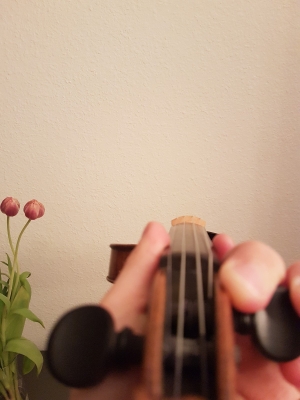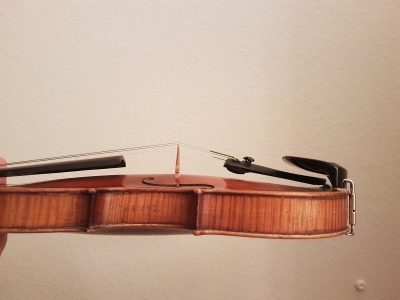Welcome to our forum. A Message To Our New and Prospective Members . Check out our Forum Rules. Lets keep this forum an enjoyable place to visit.
Currently working on errors from the latest (SimplePress) forum update. Many issues have been resoled and others are being worked on. Thank you for your patience.
 Topic RSS
Topic RSS



 (4 votes)
(4 votes)  Offline
Offline
I just put some alphayue strings on with a new finetuner and an already existing bridge. I couldn't play, because it's alreay too late. When I tried to tune the strings sometimes the pegs did move back. Whats the best way to avoid this? Just press them more inside the pegbox or is there any sticky thing which should be applied?
What do you think about the fingerboard/bridge/finetuner ratio? What about the height of the bridge and the string height? String spacing?





Regulars
 Offline
Offline

@rokit . A good place to start is 4 to 5 mm from the string to the fingerboard end (toward the bridge) on the g string and 3 mm on the e string. Since the bridge has a radius, if the two end strings have a good clearance, the others will automatically have a proportional clearances. Playing is easier (and faster) with lower clearances, but the g string oscillating while bowed may strike the fingerboard and cause a buzz if the string is too low.
The bridge is high enough for you to go with either steel core or synthetic core strings. What you have should work well for you.
Put a small indentation on the bridge with a needle file (no more than 1/3rd string height) for each string and lubricate the knotch with pencil graphite. The spacing in photo is the standard practice. No harm in spacing them to more fully across fingerboard if you have wide fingers. The bridge can be provided with a small piece of parchment under the e string to protect the wood from splitting. The parchment is held on with a dot of ca glue.
The pegs are typically secured by applying inward pressure toward peg box. A small amount of chalk or commercial peg dope (a liquid mixture of rosin, soap and glycerin) can be applied for additional friction. My violin uses a set of 4:1 reduction planetary geared pegs, so I am out of my field in this particular area.
Standard tuning is a=440 hertz. As a beginner playing synthetic core strings, you may well find no problem practicing with strings at this tension. If you find your hand getting sore, try setting your tuner at a=434 or so and work up 2 hertz per month.
Success is the progressive realisation of a worthy ideal. —Earl Nightingale.
Regulars
 Offline
Offline





Irv said
@rokit and others. I assume that the forum image of a violin on the right hand side (over the caption “check it out”) is consistent when viewed in Europe. If so, see that the string spread is wider than what you have.
Can it be tested that way? Different screens may have slightly different screen ratios. To me it looks like the Fiddlerman image may be stretched a tiny amount laterally.
Andrew
Verified human - the ignominy!
Regulars
 Offline
Offline

Aspect ratio is the least of my worries. I just noticed that the violin in my example was a five string! No matter, the analogy is constant. I just think that maximising the spatial capacity of the finger board should offer cleaner left hand work.
Success is the progressive realisation of a worthy ideal. —Earl Nightingale.
Regulars
 Offline
Offline





Regulars
 Offline
Offline

Another happy customer. @rokit . Being new to the violin, it may be wise to stock up on a couple more “e” strings. As they are working within a few percent of their maximum load, they do not take kindly to any beginner abuse. It is not unusual for a beginner to try to electrically tune one string while cranking the peg and/or fine tuner of another.
Success is the progressive realisation of a worthy ideal. —Earl Nightingale.
Regulars







Regulars
 Offline
Offline





Regulars







Gordon Shumway said
AndrewH said
I second Irv's comment about stocking up on extra E strings. They break far more frequently than any other string....most violinists...continue to break an E string every 5-10 years.
Do you mean months, or have you suddenly become an ironist?
I mean years. I expressly mentioned that this is after getting beyond the beginner stage, which is when most broken strings happen.
Regulars
 Offline
Offline





So it's beginners you recommend stock up on E strings? Sorry, that wasn't clear to me.
As it happens, my teacher told me to get string sets with a wound E, as a plain steel E might hurt my fingers, so I ordered spare wound Es, but I'm still using the original supplied sets with plain steel Es, and frankly these strings are so thin I can barely feel them under my fingers, although it may be because they have been toughened up a little bit by guitar and uke playing.
Ooh, I'm 4 posts away from 1,000. I heard Pierre sends you a free set of strings with every 1,000 posts!
Andrew
Verified human - the ignominy!
Regulars







No, I actually mean everyone, though it's especially advisable for beginners. For one, you always need to have spares, and it's the one string that has a noticeable chance of breaking. There have been instances of violinists breaking two E strings in the same concert, so it's best to have at least two spares. (Irv only suggested "a couple" extras in the post that I agreed with.) Second, E strings tend to need to be replaced sooner than the others even when they don't break, both because they are operating so close to maximum load and because violinists spend so much time playing on their E strings. Some violinists buy an extra E string with every full set and change their E string twice as often as the others. When I lived in the Los Angeles area I remember visiting one shop that offered violin strings in sets of five with two E strings.


 Log In
Log In Register
Register







 Online
Online

